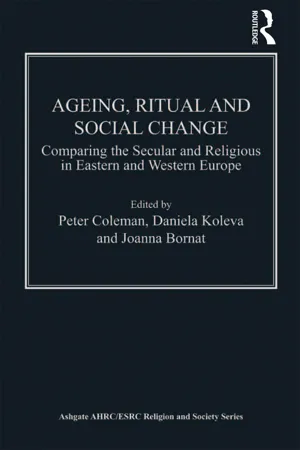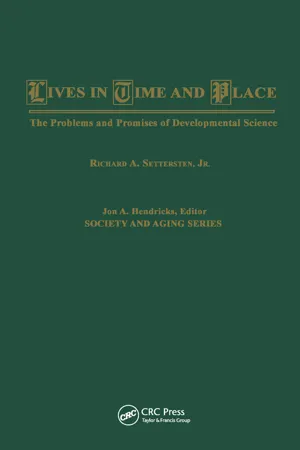Social Sciences
Age and Religion
Age and religion refer to the relationship between an individual's age and their religious beliefs and practices. Studies in this area explore how age influences religious participation, beliefs, and attitudes. Research often examines how religious affiliation and commitment change across different stages of life, and how generational differences impact religious identity and behavior.
Written by Perlego with AI-assistance
Related key terms
4 Key excerpts on "Age and Religion"
- eBook - ePub
Ageing, Ritual and Social Change
Comparing the Secular and Religious in Eastern and Western Europe
- Daniela Koleva, Peter Coleman(Authors)
- 2016(Publication Date)
- Routledge(Publisher)
PART ISetting the ScenePassage contains an image
Chapter 1Introduction:Ageing and Ritual in a Changing Europe
Peter G. Coleman, Daniela Koleva and Joanna BornatReligion and Ageing
The study of religion and ageing is surprisingly neglected. Although transmission of religion and socialisation into its practices usually occur very early in life, the significance of religion often becomes more important in later years. Indeed it can be argued that, as one of human culture’s major products, religion is a major benefactor to age, offering sustenance in the face of biological decline and death (Baltes 1997; Coleman et al. 2011a). These benefits take both psychological and social forms in contributing to a sense of continued meaning and purpose in life, and providing continuity of identity and belief in the face of disruptive social change. In addition, religion often provides tangible physical benefits to older people. Many religions have been at the forefront in creating institutions to cater for older people’s care needs. Religious organisations also provide social roles for older people, including the transmission of religious practice and teaching, directly within their own structures and indirectly in their encouragement of intergenerational bonds within the family and wider community.Thus the steady decline of religious affiliation and attendance that has taken place over the last half-century and more in many Western societies has implications for the future of ageing (Coleman, Mills and Speck 2006). We do not yet know whether the non-religious spiritual and humanist philosophies of life that are becoming more available as lifestyle choices to the new generations of older people will offer the same degree of support in late life as religion has done in the past (Howse 1999). Unfortunately these questions have only recently been asked because the study of religion has been neglected by the social sciences in the greater part of the twentieth century, despite the seminal influence of earlier scholars as Emile Durkheim and William James. The new interdisciplinary field of gerontology that developed after the Second World War has also given relatively little attention to the role that religion and alternative meaning-giving philosophies of life play in older people’s daily lives. We need to find answers soon because the first predominantly non-religious generations of older people are almost upon us in the UK and much of Western Europe. Their probably different attitudes to important age-related issues such as life prolongation and control over the moment of death, until recently dominated by religious considerations, will need close attention. - eBook - ePub
Lives in Time and Place
The Problems and Promises of Developmental Science
- R. A. Settersten(Author)
- 2018(Publication Date)
- Routledge(Publisher)
CHAPTER 2Challenges Posed by Age and Age StructuringAge lies at the heart of most theory and research on human development, regardless of discipline. But because age is an integral dimension for the interdisciplinary study of human lives, and because of its simplicity, have we taken its importance for granted? Anthropologist Fry recently noted that even the most basic questions dealing with age have been given little attention because developmental scientists have rarely asked direct questions to members of any culture about how they think about, use, and experience age and the life course (Fry, 1994, 1996).Nonetheless, age would seem important from the perspectives of both individuals and social structures, of self and society. For example, social psychologists and anthropologists have suggested that age functions as a convenient dimension with which to map social and cultural expectations about experiences and roles. Individuals use these age-linked “mental maps” to organize their own lives, the lives of others, and their general expectations about the life course (Elder, 1995; Fry, 1986; Hagestad, 1990; Hagestad & Neugarten, 1985; Hogan, 1985; Keith & Kertzer, 1984; Neugarten & Neugarten, 1986; Nydegger, 1986a; Riley, 1987). These maps, in turn, serve an important human need for order and predictability. Of course, lives as they are actually lived may sway from these cultural models of the life course (Rindfuss, Swicegood, & Rosenfeld, 1987). Nonetheless, individuals’ perceptions of these models, and the degree to which age is embedded in them, may be powerful forces in determining how the life course is actively negotiated and experienced (Fry, 1996).Similarly, age likely enters into and shapes everyday social interaction, affecting the expectations and evaluations of the individuals involved in those exchanges. However, little is known about the manner and degree to which it does so. Along these lines, age has been described as a “diffuse status characteristic,” in that individuals may use cues about others’ ages to make more general assumptions about their attributes and abilities (Boyd & Dowd, 1988). This practice would seem especially likely when little else is known about a person besides obvious “master status” and generally visible characteristics such as race, sex, and perhaps social class. As Boyd and Dowd (1988, p. 87) point out, the “diffusiveness” of these characteristics probably has its origin in their “portability” in that they always accompany the individual. - eBook - ePub
Not by Faith Alone
Religion, Law, and Adolescence
- Roger J. R. Levesque(Author)
- 2002(Publication Date)
- NYU Press(Publisher)
Despite setting themselves up for considerable challenges, models of religious orientation and development that seek to describe a general, normative process of development offer much to our discussion. The contributions of existing research and models become quite apparent when coupled with current understandings of human development. First, significant variation exists in people’s abilities to conceive of religious constructs. Although much clearly relies on individuals’ cognitive capacities, much also relies on their social circumstances and surroundings; most notably, many nonbelievers view religious beliefs as magical, devoid of reality, or simply immature, while believers argue that those beliefs represent higher thinking. Second, the study of faith development helps us to understand religious diversity. Although much heated debate centers on the existence of universal stages, those debates do not detract from the claim that the formal structuring of stages reveals only part of one’s worldview; environments provide structuring and deconstructing powers and may either stifle or enrich development. Third, individuals actively construct their own religious worldviews. Religious development unfolds through a process determined by what adolescents bring to their environment and what the environment provides them. Last, although individuals may reject formal religion, the social nature of development necessarily includes matters of faith, trust, hope, and other orientations that people adopt as their general approach to their world. Individuals continuously reconstruct their religious orientations as experiences impact how they define their place and purpose in life. Matters of faith, spirituality, and religiosity all affect people’s worldviews as people deal with both existential and everyday matters. These four considerations, and the variety of religious beliefs and contexts, suggest that it makes practical sense to approach religious knowing and commitment as an aspect of human development in general and to understand that religious development requires attention to other individualistic, developmental and social factors. - eBook - ePub
- John Blando(Author)
- 2014(Publication Date)
- Routledge(Publisher)
7 The Culture and Context of Old Age We all live with the intention of being happy; our lives are all different and yet the same.—Anne Frank (1929–1945)Moral excellence is the result of habit. We are made just by performing just acts, temperate by performing temperate acts, brave by performing brave acts.—Aristotle (384–322 BCE)CHAPTER OVERVIEWIn this chapter, we will begin to look at the culture of old age. We will consider older adults as a unique cultural group, with particular ways of being, specific shared histories, distinct needs, and discrete strengths. We will consider issues of spirituality, diversity, and social justice. We will explore the differences between spirituality and religion, address issues of cultural diversities in elders, and touch on some of the social justice issues—economics and social class—as they relate to later life.SPIRITUALITY AND RELIGION Religion in the United StatesA recent national survey suggested that about 81% of people in the United States identified themselves with a religion: 77% Christian and about 4% non-Christian (see Kosmin, Mayer, & Keysar, 2005). Fourteen percent identified as nonreligious (including atheists, agnostics, humanists, secular, and those who stated they were nonreligious), and about 5% decline to answer the question (Kosmin et al., 2005). Adults age 65 and older were more likely to identify as religious or somewhat religious than those under age 65 (Kosmin et al., 2005).Strikingly, about 40% of the survey respondents who identified with a religion did not belong to a religious community or organization such as a church, temple, or congregation (Kosmin et al., 2005), suggesting that a large percentage of people more fittingly might be considered spiritual rather than religious. But what is the difference between being spiritual and being religious?Spirituality and ReligionAlthough some identify spirituality and religion
Learn about this page
Index pages curate the most relevant extracts from our library of academic textbooks. They’ve been created using an in-house natural language model (NLM), each adding context and meaning to key research topics.



